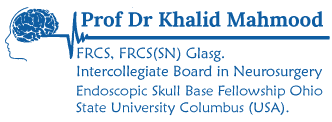Prof Khalid and his team have extensive expertise with both conventional and keyhole approaches totaling over 1000 such procedures over the past two decades. This large experience allows us to provide a truly tailored approach best suited for each patient.
Learn About Different Keyhole Approaches:
Supraorbital Eyebrow Approach
The supraorbital eyebrow approach is useful for many patients with meningiomas, craniopharyngiomas and other tumors near the optic nerves and pituitary gland, as well as gliomas and metastatic brain tumors in the frontal and temporal lobes.
This versatile, minimally invasive approach minimizes normal tissue disruption and brain retraction, allowing for a more direct approach to these lesions. Occasionally, an abdominal fat graft may be necessary to seal large nasal sinus defects.
This approach is typically performed with the assistance of an endoscope, allowing for further visualization. As such, patients recover well and have good cosmetic outcomes long term.we have to our credit the largest number of Endoscopic Brain Tumor surgeries through Eyebrow incision in Pakistan.
Endoscopic Endonasal Approach (through the nostrils)
Endoscopic Endonasal Surgery (through the nostrils) is ideal for most pituitary adenomas, craniopharyngiomas, chordomas, sinus carcinomas, olfactory neuroblastomas and some midline meningiomas of the tuberculum sellae, clivus, cavernous sinus, Meckel’s cave, orbital apex and orbit. We have published extensively on this topic.
Prof Khalid started this surgery at Lahore in 2010 and is currently doing 80 cases of Pituitary tumors through nose with endoscope each year which is the largest number in the country.
Mini-Pterional Approach
This approach minimizes normal tissue disruptions and brain retraction while maintaining a cosmetic outcome. The Mini-Pterional Approach offers a direct avenue for certain sphenoid wing and parasellar meningiomas, other tumors of the cavernous sinus and Meckel’s cave, orbital lesions as well as temporal lobe gliomas and metastatic brain tumors.
Retromastoid Approach (behind the ear)
The retromastoid approach (also known as the retrosigmoid approach) uses a small window behind the ear to reach and remove acoustic and trigeminal schwannomas, meningiomas, epidermoid tumors, and tumors of the cerebellum such as hemangioblastomas and metastatic brain tumors.
It is also the main approach for microvascular decompression of the cranial nerves (for trigeminal neuralgia or hemifacial spasm). This operation is augmented with the introduction of the endoscope, allowing for visualization around corners, limiting the need for extensive tissue removal or brain retraction.
Occasionally, an abdominal fat graft is necessary to seal the opening and prevent a cerebrospinal fluid (CSF) leak. Overall, this operation is associated with great access to the pathology with minimal cosmetic or soft-tissue damage and relatively quick patient recovery.



